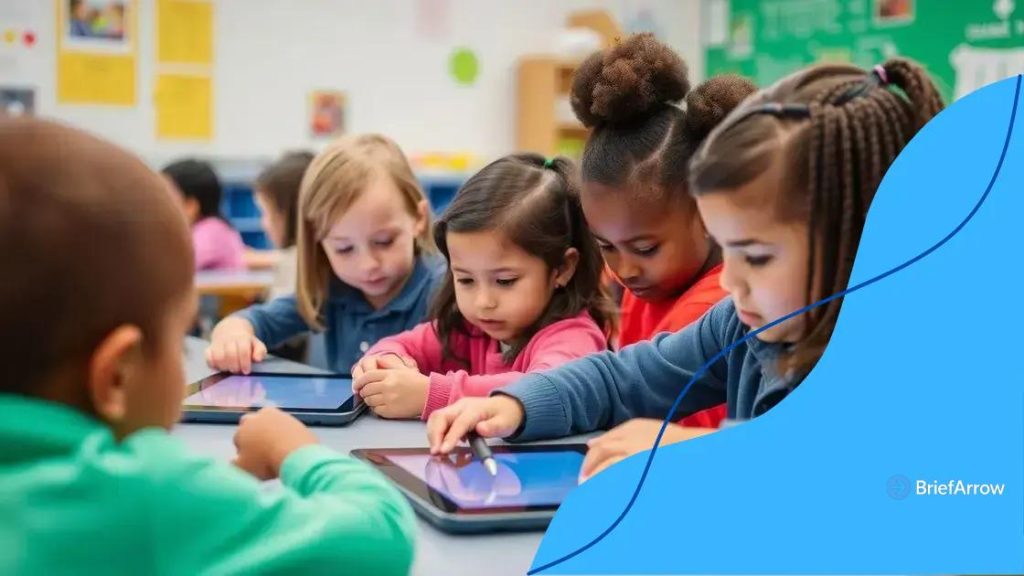Research on screen time’s learning impact: what to know

Anúncios
Research on screen time’s learning impact shows that while it can enhance educational experiences, excessive use may hinder cognitive development, making parental moderation crucial for healthy habits.
Research on screen time’s learning impact shows that excessive use can affect kids’ development. But how does it really shape their educational experiences? Let’s dive deeper into what this means for our children.
Anúncios
Understanding screen time and its definition
Understanding screen time is essential in today’s digital age. It refers to the time spent using devices like smartphones, tablets, and computers. Children and adults alike engage with screens for various purposes such as learning, entertainment, and communication.
This kind of technology has become an integral part of our lives. However, it’s crucial to understand both its benefits and drawbacks. While screen time can enhance learning through interactive apps and educational videos, excessive use may lead to negative effects.
Defining Screen Time
Screen time encompasses all activities that involve a screen. This can include:
Anúncios
- Watching TV shows or movies
- Playing video games
- Browsing social media
- Using educational apps
Each of these activities can contribute differently to a child’s development. For instance, educational content can be beneficial, while mindless scrolling through social media may have adverse effects.
Types of Screen Time
There are different types of screen time that parents should recognize. They include:
- Passive screen time: Activities like watching TV or videos without interaction.
- Interactive screen time: Engaging with games or apps that require user interaction.
- Educational screen time: Use of screens for learning and educational purposes.
Understanding these types helps in making informed decisions about how much time should be allotted for each type. Balance is key in ensuring that children get the best benefits without overwhelming them with too much screen use.
Guidelines from various health organizations suggest limits on daily screen time. For children, it is advised to focus on quality over quantity. Opting for educational content while ensuring ample time for offline activities can nurture a healthy development environment.
The effects of screen time on cognitive development
The effects of screen time on cognitive development are critical to understand, especially for parents and educators. As screens dominate our daily lives, knowing their impact on children’s brains is essential for healthy growth.
Research indicates that excessive screen time can hinder important skills. It may affect attention span, memory, and problem-solving abilities. When kids spend too much time on screens, they miss out on activities that develop these skills.
Negative Impacts of Excessive Screen Time
Too much screen time can lead to various issues, such as:
- Reduced Attention Span: Children may struggle to focus on tasks away from screens.
- Impaired Social Skills: Overuse may limit face-to-face interactions, essential for developing communication.
- Lower Academic Performance: Excessive use can interfere with homework and learning time.
Studies show that children who use screens for more than two hours a day may experience these negative effects. It’s crucial to encourage balance and moderation.
Benefits of Controlled Screen Time
While there are risks, not all screen time is harmful. Educational apps and programs can facilitate learning.
- Interactive Learning: Engaging educational content can enhance learning experiences.
- Skill Development: Certain games can improve cognitive skills, such as memory and sequencing.
- Access to Information: Screens provide valuable resources for research and exploration.
Finding a healthy mix between beneficial and detrimental screen time is vital. Parents should guide children on how to use screens wisely, focusing on quality over quantity.
Encouraging other activities like reading, outdoor play, and social interactions can support cognitive development. By recognizing these aspects, families can create a balanced environment to foster healthy growth.
Best practices for managing screen time for children

Best practices for managing screen time for children are essential for fostering a healthy balance in their lives. Ensuring that kids enjoy technology while minimizing potential negative effects can be achieved through thoughtful guidelines.
Setting limits on screen time is one of the most effective strategies. Establishing a specific amount of time each day helps children understand when to engage with screens and when it’s time to unplug.
Creating a Balanced Schedule
Developing a daily routine that includes both screen time and other activities is key. Some tips include:
- Designated screen hours: Set specific times for using screens during the day.
- Incorporate breaks: Encourage short breaks to promote physical activity and reduce eye strain.
- Create tech-free zones: Establish areas in the home where screens are not allowed to encourage family interaction.
By following a structured schedule, children can learn to manage their time effectively. Balance is crucial.
Choosing Quality Content
It’s not just about the amount of screen time, but also the quality. Parents should focus on:
- Educational apps and programs: Select content that promotes learning and engagement.
- Interactive activities: Choose games that require problem-solving skills or creativity.
- Monitoring content: Regularly review what children are watching or playing to ensure it’s appropriate.
Encouraging interactions with educational content can significantly enhance the learning experience.
Engaging in screen time together also fosters connection. Watching shows or playing games as a family can create shared experiences. Discussing what children see helps reinforce learning and critical thinking.
Ultimately, being involved in your child’s screen time not only promotes healthier habits but strengthens your relationship, making tech usage a collaborative experience rather than a solitary one.
Alternative activities to promote learning without screens
Alternative activities to promote learning without screens are essential in fostering a well-rounded education for children. While screens can offer valuable learning tools, engaging in offline activities helps develop critical thinking and social skills.
Incorporating activities that stimulate creativity and curiosity is vital. Simple tasks like reading a book, playing an instrument, or crafting can enrich children’s minds significantly.
Creative Play
Creative play is one of the best ways to promote learning. Here are some great options:
- Arts and Crafts: Activities like painting, drawing, or building with blocks encourage imagination.
- Storytelling: Reading aloud or creating stories helps develop language skills and fosters a love for books.
- Role-Playing: Engaging in pretend play can teach problem-solving and empathy.
These activities not only provide fun but also enhance cognitive development in children.
Outdoor Exploration
Outdoor activities are another excellent way to promote learning. Exploring nature allows kids to learn about the world around them. They can:
- Go on nature walks: Encourage observation of plants and animals, stimulating curiosity.
- Garden: Learn about growth and responsibility by planting seeds.
- Play sports: Develop teamwork and motor skills through physical activities.
Spending time outdoors can lead to enhanced physical health and improved mood.
In addition to creative and outdoor activities, incorporating board games and puzzles can sharpen critical thinking skills. Engaging in games that require strategy boosts problem-solving capability while fostering social interaction.
Using everyday chores as learning opportunities can also be beneficial. For instance, cooking together can teach kids about measurements and following instructions. Such activities create a fun environment for learning valuable life skills.
Parents’ role in moderating screen time
Parents’ role in moderating screen time is crucial in today’s digital world. They play an essential part in guiding their children to use screens wisely while encouraging healthy habits.
One of the first steps parents can take is to establish clear guidelines for screen use. Setting specific time limits helps children understand the importance of balancing activities. Discussing the reasons behind these limits can make children more receptive to them.
Establishing Consistent Rules
Creating a consistent screen time policy is important for all family members. Here are some effective strategies:
- Set daily time limits: Decide how much time is appropriate each day for screen use.
- Select suitable content: Review games, apps, and shows to ensure they are age-appropriate.
- Role model behavior: Children imitate their parents. Show responsible screen use to instill good habits.
By providing a stable framework, parents can help children learn moderation and make informed choices.
Encouraging Open Communication
Open communication about technology usage also plays a significant role. Parents should engage their children in conversations about what they are viewing or playing. This can help in identifying any concerns and understanding the content better.
Furthermore, setting aside family time without screens fosters connection. This allows for deeper discussions about each other’s experiences and feelings. Participating in activities together can strengthen the family bond.
Parents should also monitor their children’s screen habits regularly. This includes checking for excessive use or dependence on devices. If parents notice changes in behavior, they can address them sooner rather than later and provide the necessary support.
By actively involving themselves in their children’s screen time, parents can guide them toward making responsible choices. This involvement promotes healthier lifestyles and enhances family relationships.
FAQ – Questions about managing screen time for children
Why is it important to manage screen time for children?
Managing screen time is essential to ensure children develop healthy habits, balance activities, and avoid potential negative effects on their physical and mental health.
What are some effective ways to set limits on screen time?
Setting daily time limits and establishing tech-free zones at home can help children understand when it’s appropriate to use screens.
How can I encourage my child to engage in alternative activities?
Promote activities such as reading, playing outdoors, or doing arts and crafts to stimulate creativity and reduce screen dependency.
What role do parents play in their children’s screen time habits?
Parents should actively monitor their children’s screen habits and engage in discussions about content, ensuring they make informed choices about their technology usage.